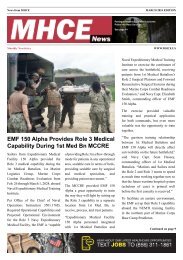Create successful ePaper yourself
Turn your PDF publications into a flip-book with our unique Google optimized e-Paper software.
WWW.MHCE.US Monthly <strong>Newsletter</strong> | 3<br />
As a result, the services are seeking to shed nearly 18,000 frontline health<br />
care workers and the DoD has targeted 50 military medical facilities for<br />
downsizing or closure.<br />
At the same time, the DoD is introducing a new electronic health record<br />
system, MHS Genesis, to select installations.<br />
But these efforts came to a stop March 24 because of the pandemic.<br />
McCaffery said Tuesday the initiatives have now resumed.<br />
"We're in the midst of implementing a collection of reforms that, taken<br />
together, represented the most dramatic change to the system in over<br />
three decades," he said.<br />
McCaffery explained that the DoD has launched its electronic health<br />
record system at 21 sites and plans to roll out five additional "waves" in<br />
<strong>2021</strong>.<br />
The establishment of administrative markets also has resumed, and the<br />
DHA is helping the services determine their requirements for military<br />
medical personnel, defense officials said.<br />
But one aspect of military health reform -- the restructuring of 50 MTFs,<br />
based on community assessments of available medical care through<br />
private providers -- will have to be reassessed, Defense Health Agency<br />
Director Lt. Gen. Ronald Place said.<br />
The DoD announced in <strong>February</strong> the list of facilities slated for<br />
restructuring based on community assessments of available medical care<br />
by private physicians through the Tricarenetwork. Under the plan, 37<br />
outpatient clinics would begin serving only active-duty personnel, and<br />
three were slated to close.<br />
But those recommendations will need to be tweaked, since many<br />
physician offices and even hospitals cut services or closed permanently<br />
during the pandemic, Place said.<br />
"Hundreds, if not thousands, of physician offices have either downsized<br />
or closed, and so the assumptions that went into the data ... the data that<br />
went into the initial validation of what might be available outside of the<br />
gates ... weren't true any more," he said.<br />
The DoD is reassessing the communities and will have new data compiled<br />
later this month. Depending on the outcome, the DHA will proceed with<br />
realignment and closures in locations where the community can support<br />
new patients at private practices, Place said.<br />
The secretaries of the Army, Navy and Air Force, along with the branch<br />
chiefs of the Army, Navy, Air Force, Marine Corps and Space Force, sent<br />
a memo to then-Defense Secretary Mark Esper on Aug. 5 calling for the<br />
return of all military hospitals and clinics already transferred to the DHA<br />
and suspension of any planned moves of personnel or resources.<br />
They said the COVID-19 outbreak has demonstrated that the reform<br />
effort introduced "barriers, creates unnecessary complexity and increases<br />
inefficiency and cost."<br />
In early March, the Air Force and Army surgeons general told the House<br />
Appropriations defense subcommittee that the reorganization is an<br />
"extremely difficult [and] complicated merger of four cultures." They<br />
suggested that the Defense Health Agency isn't ready for some of the<br />
coming changes.<br />
As the pandemic took hold, tensions that had been bubbling since the<br />
initial facility transfer erupted. At one facility, commanders and DHA<br />
leadership argued over who was responsible for the COVID-19 screening<br />
tents in the parking lot.<br />
"There are definitely turf battles going on," said the source, a DoD<br />
civilian employee. "[The services] are making it very hard."<br />
If friction continues between the branches and the Defense Health<br />
Agency, it was not apparent during a forum at AMSUS that brought<br />
together Place and the surgeons general or deputy surgeons general of<br />
the military branches.<br />
Navy Surgeon General Rear Adm. Bruce Gillingham said the Navy<br />
Bureau of Medicine is committed to training medical professionals to<br />
perform in combat and support operational requirements.<br />
Air Force Deputy Surgeon General Maj. Gen. Sean Murphy said the<br />
Air Force Medical Service is "really about our operational forces," and<br />
Army Surgeon General Lt. Gen. Scott Dingle said his service is honing<br />
its forces to ensure that soldiers receive "world-class care."<br />
"We fully understand we must reform. It is the law," Dingle said. "As we<br />
go through reorganization, [soldiers] will still get care, the world-class<br />
medical response, the world-class engagements they need to ensure that<br />
they're ready to go out the door to deploy, fight and win when called<br />
upon."<br />
"Those areas where it seems as though the capabilities that exist ... [and]<br />
really can do that function, we'll set forth a plan for the process of descoping<br />
capabilities at those installations and the personal handoff of<br />
care requirements for individual patients to practitioners outside the<br />
gates," he said.<br />
Roughly 200,000 Tricare beneficiaries, including 80,000 active-duty<br />
family members, are expected to be affected by the changes.<br />
Critics have called the effort to shift non-uniformed beneficiaries to<br />
Tricare simply a form of privatization -- an effort to save taxpayer dollars<br />
that undermines the department's obligation to provide care for military<br />
personnel and their families.<br />
But McCaffery said the reforms are designed to make sure that the<br />
military services have medical personnel trained for warfighting and to<br />
improve patient care for all.<br />
"Having both our private-sector care system and our direct care system<br />
under one joint entity will allow us to have more standardized health care<br />
delivery policies and business practices across the entire military health<br />
system. And that will go a long way to reducing undesirable variation for<br />
both our providers and our patients," McCaffery said.<br />
In August, the military branches called for a halt to the transfer of medical<br />
facilities to the DHA,saying the plan is not viable.


















